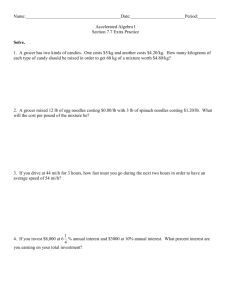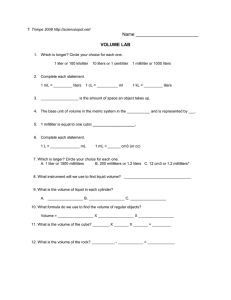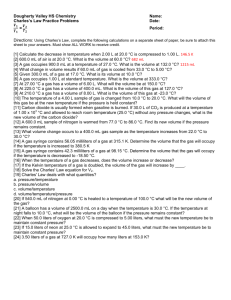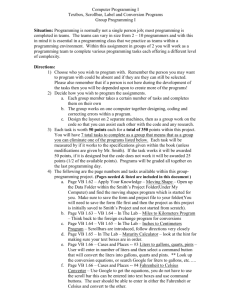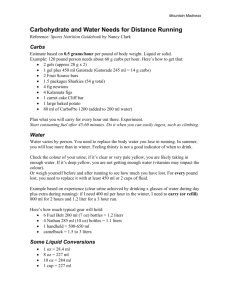Document 12540151
advertisement
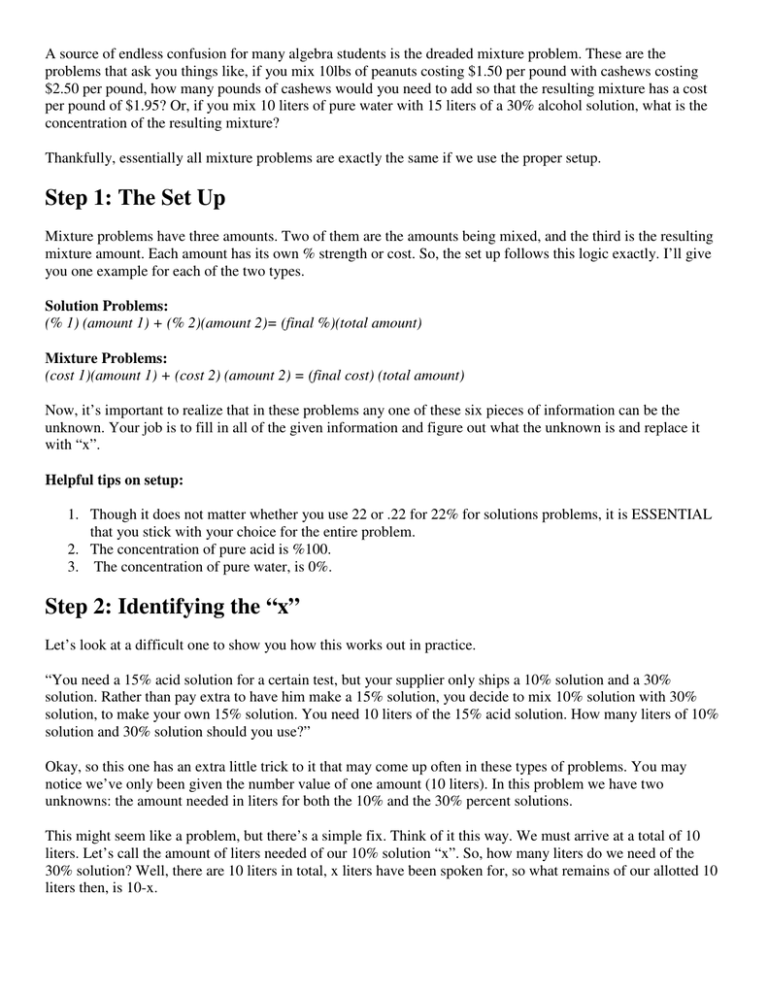
A source of endless confusion for many algebra students is the dreaded mixture problem. These are the problems that ask you things like, if you mix 10lbs of peanuts costing $1.50 per pound with cashews costing $2.50 per pound, how many pounds of cashews would you need to add so that the resulting mixture has a cost per pound of $1.95? Or, if you mix 10 liters of pure water with 15 liters of a 30% alcohol solution, what is the concentration of the resulting mixture? Thankfully, essentially all mixture problems are exactly the same if we use the proper setup. Step 1: The Set Up Mixture problems have three amounts. Two of them are the amounts being mixed, and the third is the resulting mixture amount. Each amount has its own % strength or cost. So, the set up follows this logic exactly. I’ll give you one example for each of the two types. Solution Problems: (% 1) (amount 1) + (% 2)(amount 2)= (final %)(total amount) Mixture Problems: (cost 1)(amount 1) + (cost 2) (amount 2) = (final cost) (total amount) Now, it’s important to realize that in these problems any one of these six pieces of information can be the unknown. Your job is to fill in all of the given information and figure out what the unknown is and replace it with “x”. Helpful tips on setup: 1. Though it does not matter whether you use 22 or .22 for 22% for solutions problems, it is ESSENTIAL that you stick with your choice for the entire problem. 2. The concentration of pure acid is %100. 3. The concentration of pure water, is 0%. Step 2: Identifying the “x” Let’s look at a difficult one to show you how this works out in practice. “You need a 15% acid solution for a certain test, but your supplier only ships a 10% solution and a 30% solution. Rather than pay extra to have him make a 15% solution, you decide to mix 10% solution with 30% solution, to make your own 15% solution. You need 10 liters of the 15% acid solution. How many liters of 10% solution and 30% solution should you use?” Okay, so this one has an extra little trick to it that may come up often in these types of problems. You may notice we’ve only been given the number value of one amount (10 liters). In this problem we have two unknowns: the amount needed in liters for both the 10% and the 30% percent solutions. This might seem like a problem, but there’s a simple fix. Think of it this way. We must arrive at a total of 10 liters. Let’s call the amount of liters needed of our 10% solution “x”. So, how many liters do we need of the 30% solution? Well, there are 10 liters in total, x liters have been spoken for, so what remains of our allotted 10 liters then, is 10-x. Using this simple trick we can express both of our unknowns in terms of a single variable. It doesn’t even matter which of the amounts we call x and which we call 10-x, provided we keep track of which is which. Step 3: Working the Problem Let’s take that same example problem listing only the most important bits. “You decide to mix 10% solution with 30% solution, to make your own 15% solution. You need 10 liters of the 15% acid solution. How many liters of 10% solution and 30% solution should you use?” Okay, let’s put it into our setup for a solution problem. I’ll be putting percents in decimal form throughout as that is my preference. .10(unknown amount) + .30(unknown amount 2) = .15(10) Now, we talked about identifying the x above. We figured out that we must call one of the unknowns x, and the other 10-x. So now, let’s plug that in. .10(x)+.30(10-x) = .15(10). Now, let’s solve it! Step 1: Foil .10x+3-.3x= 1.5 Step 2: X’s on one side by subtracting 3 from both sides .1x-.3x= -1.5 Step 3: Combine like terms -.2x= -1.5 Step 4: Divide by -.2 x= 7.5 Step 5: Find the other unknown x=7.5 10-x= 10-7.5= 2.5 Step 6: Interpret the result Since x was used to fill the unknown amount of the %10 solution, we have 7.5 liters of the 10% solution, and 2.5 liters of the 30% solution to end up with 10 liters of our desired 15% solution. Step 7: Check your work .10 (7.5) + .30(2.5) = .15(10) .75+.75= 1.5 This is a true statement. So there you have it. Practice this method and mixture and solutions problems will be a walk in the park!
